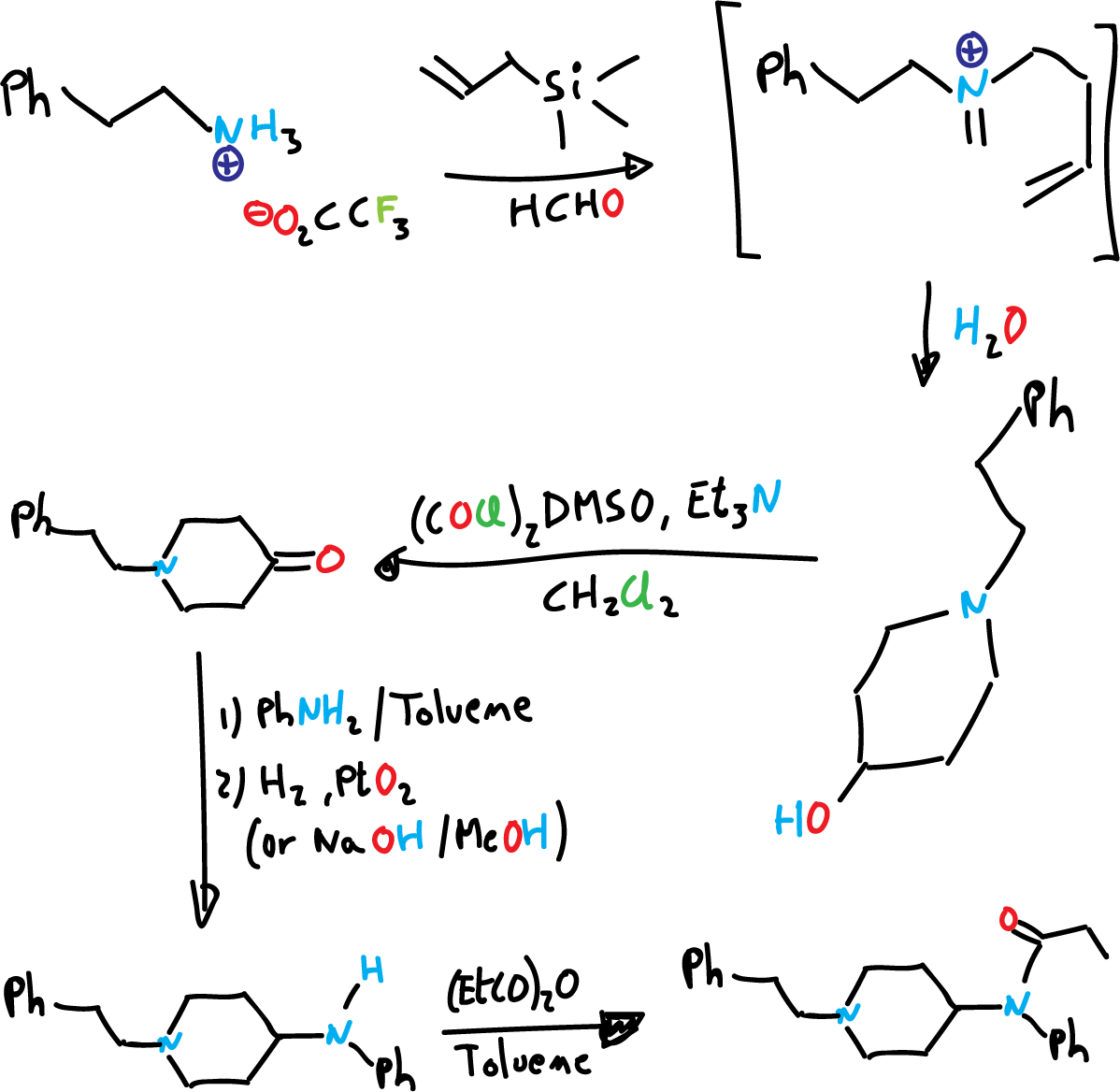Written by J.A Dobado | Last Updated on April 22, 2024
What is fentanyl?
Fentanyl, also spelled fentanil, (molecular formula C22H28N2O) is a potent opioid used as an analgesic and anesthetic. It is also used as a recreational drug, sometimes mixed with heroin, cocaine or methamphetamine, and its potentially fatal overdose effects can be neutralized with naloxone.
Fentanyl is also used to manufacture counterfeit drugs marketed as oxycontin, xanax, adderall and other types of pills.
Its IUPAC name is N-phenyl-N-[1-(2-phenylethyl)piperidin-4-yl]propanamide.
 |
| 3D Structure |
Fentanyl has the chemical structure of phenylethylpiperidone.
Total synthesis of fentanyl
Fentanyl and derivatives are synthesized by modifications of meperidine. Meperidine is a fully synthetic opioid, and other members of the phenylpiperidine family, such as alfentanil and sufentanil, are complex versions of this structure.
A total synthesis of fentanyl has been reported by Suh et al. in 1998, starting from a single phenylethylamine and by a four-step sequence.
The key step in this synthesis involves efficient construction of the phenylethylpiperidone skeleton via aminomethylation-cyclization followed by Swern oxidation.

Physico-chemical properties
Fentanyl has a density of 1.1 g/cm3. Its melting point is 87.5 ºC, and its molar mass is 336.479 g/mol.
Like other opioids, fentanyl is a weak base that is highly lipid-soluble, protein-bound and protonated at physiological pH. All these factors allow it to rapidly cross cell membranes, which contributes to its rapid effect on the body and the central nervous system.
International Chemical Identifier
We provide identifiers InChI key of the IUPAC for, the main compounds described in this section in order to facilitate the nomenclature and formulation of chemical compounds and the search for information on the Internet for these compounds.
| fentanyl | PJMPHNIQZUBGLI-UHFFFAOYSA-N |
Detrimental effects of fentanyl
Fentanyl is a synthetic opioid that has become increasingly common in society. It is often prescribed to treat chronic or acute pain in cancer patients, but it is also illegally used as a recreational drug due to its heroin-like effects.
However, the consumption of fentanyl has detrimental effects so devastating on society that many countries have declared a public health crisis due to the increase in fentanyl-related deaths. These effects include:
- Overdose: Fentanyl is an extremely potent opioid, up to 100 times stronger than morphine. As a result, even a small amount can cause an overdose. Symptoms include difficulty breathing, slow heartbeats, confusion and coma, and can be fatal.
- Addiction: Fentanyl is highly addictive, and its use can quickly lead to physical and psychological dependence. Users often need more and more drug to achieve the same effect, which can lead to a spiral of consumption.
- Increased crime: Fentanyl addiction often leads to criminal behavior to obtain funds to acquire the drug. In addition, drug dealers often cut fentanyl with other dangerous substances, which can lead to injury and death.
- Public health impact: The increase in fentanyl consumption has led to an increase in the number of users sharing needles, which increases the risk of disease transmission such as HIV and hepatitis C. In addition, the cost of treating fentanyl addicts and associated medical complications can be overwhelming for healthcare systems.
- Economic impact: Fentanyl addiction can have a devastating economic impact on individuals, families, and communities. Users may lose their jobs and have difficulty maintaining healthy relationships, which can lead to poverty and homelessness.
In conclusion, the consumption of fentanyl has detrimental effects so devastating on society that it has become a public health crisis in many countries. It is important for governments, medical professionals, and society as a whole to work together to reduce fentanyl use and provide treatment and support to those suffering from addiction.